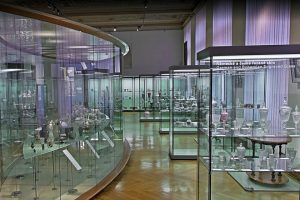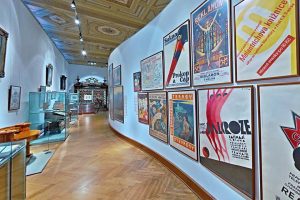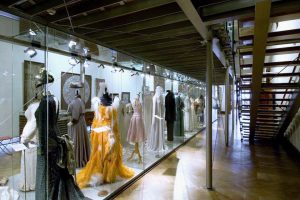Time machines, a new permanent hall dedicated to the collection of clocks and watches was newly opened in Museum of Decorative Arts In Prague. The Museum commemorates the 120th anniversary of its existence in 2005 and the aim of the museum is to open collections in the whole genre spectrum. However, the main building of the museum is currently full. On the first floor there is a permanent exhibition UPM “Stories of materials”, built since 2000, the second floor serves as a depository. In the current situation, therefore, the hall called “Time Machines” is the last section to access another part of the collections, since insufficient space can only be solved by building a new building.
The collection of clocks, watches and measuring instruments shows the changes of time measurement especially in terms of artistic design of clock boxes and at the same time documents the development of clock mechanism mechanics. So far only a few museum experts have worked on the collection. The first major exhibition of clocks was organized in 1977, another one was prepared by UPM in 1998.
This ensemble, expanded with new additions and with greater emphasis on the diversity of types, became the basis of the new permanent exhibition hall. Collections of clocks and watches of the Museum of Decorative Arts in Prague are among the most important and valuable collections of this institution. Despite the common theme of the passage of time, which is as old as mankind itself, clocks and watches belong to two different museum collections.
The collection of clocks is one of the largest and richest in the Czech Republic. Unlike the National Technical Museum, which focuses on the mechanical nature of the clock, the Museum of Decorative Arts in Prague focuses mainly on artistically shaped and decorated clocks, thus presenting a large collection of table clocks, a spectacular collection of watches and, above all, a remarkable collection of interior clocks.
The interior wheel clock has been a rarity since its inception and their external appearance has therefore been given extraordinary care. As in other types of arts and crafts, they reflect the changing stylistic view, manifested in various periods by the specific position of the clock in interior decoration. Even prominent artists, architects, sculptors and painters participated in the creation of clock boxes, emphasizing the importance of the clock as a distinctive element of contemporary style and artistic development. The clock was the pride of the owner and as such is a testament to the high-end craftsmanship of his time. Hence their collector’s attractiveness stems.
The museum owns several specimens of table and tower clocks, which have been an important part of interiors since the 16th century. The collection also includes a small set of sundials and astronomical instruments by prominent European creators (Johann Steinmeissel, Erasmus Habermel, Andreas Pleninger, Johann Engelbrecht). The tradition of manufacturing these instruments in Prague is related to the boom in astronomy and astrology during the reign of Emperor Rudolf II. at the turn of the 16th and 17th centuries. They came into the collection from private collections of patrons and founders of the museum at the time of its inception.
The main focus of the collection lies in the interior aristocratic and burgher hours from the 18th and 19th centuries. The second half of the 18th century brings figural or sculpturally shaped classicist French clocks of gilded bronze, Czech and Central European from richly cut and gilded wood, later Empire, column, frame and picture from the Biedermeier period. They are a combination of artistic taste and technical skill created by the cooperation of sculptor, woodcarver, metal worker and watchmaker. They routinely showed time, date, sometimes phases of the moon, striking an hour, a half and a quarter. Wall frame and picture clocks with romantic landscapes and figural staff tried to compete with contemporary paintings. They contained gaming machines and thus fulfilled an ancient human endeavor to combine utility with entertainment.
At the beginning of the 20th century a number of prominent architects designed the clock as an essential part of contemporary interiors (Jan Koula, Dušan Jurkovič, Jan Kotěra, Josef Gočár). After the period of Art Nouveau, which only applied Art Nouveau morphology to the existing types of lessons – whether they were vegetative or geometric motifs – after the 1920s the strictly technical concept of the clock prevailed in the spirit of emerging functionalism.
The collection of watches of the Museum of Decorative Arts in Prague is part of the collection of jewelry and precious metals, which corresponds to the character of these miniature gems. From the total number of 900 specimens, of which about 300 are separate clock movements, the exhibition will show a selection of the most beautiful and interesting species in the same time period – from the 16th to the 20th century. Watches are not only the work of watchmakers, but become a clue to the imagination and art of the best goldsmiths, jewelers and emailers of their time. The work of artisans, however, remains rare exceptionally anonymous, while watchmakers are reminiscent of their names on the back platinum clockwork and sometimes dial.
The new exhibition is a publication on the museum collection of clocks and watches in Czech and English versions. Libuše Urešová. The publication focuses on the characteristics of individual groups of exhibits and on the quality and their beauty, which is supported by rich pictorial accompaniment. The book also contains an inventory of watchmaking workshops and artists who participated in the processing of the collection of clocks and watches.
Museum of Decorative Arts In Prague
Founded in 1885, the Museum of Decorative Arts in Prague (UPM) is housed in a Neo-Renaissance edifice built in 1897–1901 after the designs of architect Josef Schulz. The Museum’s rich collections include decorative and applied arts and design work ranging from Late Antiquity to the present day, with focus on European objects, particularly arts and crafts created in the Bohemian Lands. The impressive interior of the permanent exhibition “Stories of Materials” offers visitors an excursion into the history and development of decorative arts: glass and ceramics, graphic art and design, objects made in metal, wood and other materials, jewelry, clocks and watches, textiles, fashion, toys and furniture.
An integral part of the Museum is the largest Czech library specializing in the arts and related fields. The Library offers visitors on-site loan and copying services, database access and searching in the ART (Art and Architecture) subject gateway.
The UPM presents its holdings at branch museums at the chateau in Kamenice nad Lipou and the Textile Museum in Česká Skalice. The Museum also administers the Josef Sudek Gallery on Úvoz Street near Prague Castle.
Our objective is to ensure that the Museum of Decorative Arts in Prague is a place for innovative learning that facilitates the understanding of the significance of objects of decorative arts and design, in combination with architecture and other art disciplines. We aspire to contribute to the improvement of the quality of life and the preservation of creativity in an increasingly uniform environment and to create a forthcoming space for the engagement of the public and the discussion of the cultural milieu and the world that surrounds us.






